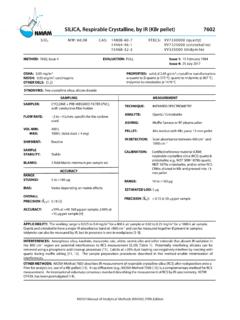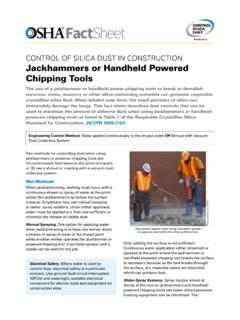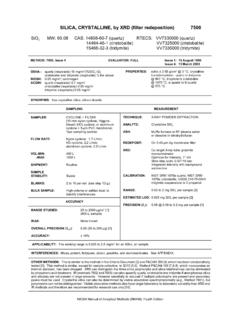Transcription of Historical picture statistics in Great Britain, 2021
1 This document is available from Page 1 of 13 Health and Safety Executive Historical picture Trends in work-related ill health and workplace injury in Great Britain, 2017 Contents Summary 3 Introduction 4 Work-related ill health 4 All illness 4 Musculoskeletal disorders 5 Stress and related conditions 5 Lung disease 6 Workplace injury 8 Fatal injury 8 Non-fatal injury 9 Working days lost 10 Links to Detailed data tables 10 Sources and Definitions 11 Data sources 11 Definitions 12 This document is available from Page 2 of 13 Blank This document is available from Page 3 of 13 Summary The document can be found at: Available data shows that in recent decades there have been large reductions in both fatal and non-fatal workplace injuries.
2 The picture for ill health is mixed, with reductions in the rate of self-reported work-related illness and specifically musculoskeletal disorders, while the rate of self-reported work-related stress and related conditions has remained broadly flat over the last twenty years. Mesothelioma deaths have continued to rise as a result of Historical asbestos exposures. Rate of self-reported work-related ill health (LFS, England estimated rate per 100,000 workers) Number of deaths from mesothelioma (HSE Mesothelioma Register, Great Britain) Rate of self-reported musculoskeletal disorders (LFS, England estimated rate per 100,000 workers) Rate of self-reported stress and related conditions (LFS, England estimated rate per 100,000 workers) Number of fatal injuries to employees (RIDDOR and earlier reporting legislation, Great Britain) Rate of self-reported workplace non-fatal injury (LFS, Great Britain; estimated rate per 100,000 workers) Rate of employer-reported non-fatal injury (RIDDOR, Great Britain.)
3 Rate per 100,000 employees) Days lost per worker due to work-related incidents (LFS, Great Britain; self-reported ill health and injury days lost) This document is available from Page 4 of 13 Introduction This report presents an assessment of the longer term trends in work-related illness and workplace injury using a range of available data sources. Note: the time period coverage is different for different data sources, with each data source generally going back at least as far as 1990. Also, sometimes we need to adjust data to enable comparisons on a broadly consistent basis for the whole period. For example, for some data the geographical coverage is adjusted to England and Wales. The latest information and trends over more recent years is available at Work-related ill health All illness In 2016/17, an estimated million workers in Great Britain were suffering from an illness which they believed was caused or made worse by work (either new or long-standing), equivalent to a rate of 3,970 per 100,000 workers (4%).
4 To look at the long term trend in work-related ill health (or injury) we generally consider how the rate has changed, rather than the number of cases, as the rate accounts for variations in the number of people in work between years. The rate of total self-reported work-related ill health showed a generally downward trend to around 2011/12; more recently the rate has been broadly flat. Since 1990, the estimated rate of work-related ill health has fallen by around one-third. (Source: Labour Force Survey, England and Wales) Figure 1: Estimated self-reported work-related ill health per 100,000 workers, England and Wales (new and long-standing cases) Source: Labour Force Survey This document is available from Page 5 of 13 Musculoskeletal disorders Musculoskeletal disorders account for a large proportion of self-reported work-related ill health - around 40 per cent of all self-reported cases in Great Britain in 2016/17.
5 Despite the increase in rate between 1990 and 1995, the rate has been generally downward over the period from 1990 to 2016/17. Since 1990 the rate has fallen by around 40 per cent. (Source: Labour Force Survey, England and Wales). Figure 2: Estimated self-reported work-related musculoskeletal disorders per 100,000 workers, England and Wales (new and long-standing cases) Source: Labour Force Survey Stress and related conditions Stress and related conditions includes cases of both stress, depression or anxiety and heart conditions and account for around 40% of all cases of self-reported work-related ill health in Great Britain in 2016/17, a similar proportion to musculoskeletal disorders. (Note: heart conditions are included alongside stress, depression or anxiety to allow consistency with definitions used in the 1995 survey).
6 The rate of stress and related conditions increased during the 1990s and has remained broadly flat since 1998/99, but has shown some fluctuations. It is likely that awareness of and attitudes to work-related stress changed in the 1990s, which will have affected reporting levels. Figure 3: Estimated self-reported work-related stress and related conditions per 100,000 workers, England and Wales (new and long-standing cases) Source: Labour Force Survey This document is available from Page 6 of 13 Lung disease Typically 3-4% of cases of self-reported work-related illness are reported as breathing or lung problems . This general category is likely to include a wide range of specific illnesses: some caused by, and others aggravated by work; some that can occur rapidly following exposure to respiratory hazards, and others that take many years to develop.
7 In 2016/17, an estimated 42,000 workers in Great Britain were suffering from a work-related breathing or lung problem (either new or long-standing). The rate of self-reported work-related breathing or lung problems reduced from around 200 cases per 100,000 workers in the early 2000s but remained broadly constant over the last 10 years, with an estimated 130 cases per 100,000 based on the latest three Labour Force Surveys. Figure 4: Estimated self-reported work-related breathing or lung problems per 100,000 workers, Great Britain (new and long-standing cases) Source: Labour Force Survey This document is available from Page 7 of 13 Specific lung diseases Long-term trends for certain specific occupational lung diseases can be assessed where data have been collected consistently over extended periods, for example based on death certificates or the Industrial Injuries Disablement Benefit (IIDB) scheme.
8 Here we show trends for mesothelioma (an asbestos-related cancer), and silicosis (a form of pneumoconiosis caused by respirable crystalline silica). Figure 5: Annual mesothelioma deaths and cases assessed for IIDB in Great Britain, 1974-2016 Sources: Death Certificates; Industrial Injuries and Disablement Benefit scheme Annual mesothelioma deaths have increased around 10-fold since 1974 and numbers are expected to remain at the current level of around 2,500 deaths per year for the rest of this decade before beginning to decline. Annual IIDB cases have followed a similar trend. These mesothelioma cases are a consequence of heavy past occupational asbestos exposures and the fact that the disease typically takes decades to develop.
9 Further information about mesothelioma and other asbestos-related disease is available at Figure 6: Annual silicosis deaths and cases assessed for IIDB in Great Britain, 1974-2016 Sources: Death Certificates; Industrial Injuries and Disablement Benefit scheme There has been a steady decline in annual deaths since 1974, with numbers in recent years about half or lower than those in the 1970s. Annual IIDB cases have tended to fluctuate considerably, though there is also evidence of a reduction over the period. Further information about silicosis and other occupational lung diseases is available at This document is available from Page 8 of 13 Workplace injury Fatal injury In 2016/17, 137 workers were killed at work in Great Britain including 101 employees and 36 self-employed workers.
10 It is the second lowest year on record after 2013/14. However, in statistical terms the number of fatalities has remained broadly level in recent years the average annual number of workers killed at work over the five years 2012/13-2016/17p is 142. While data on fatal injuries to the self-employed have only been collected since 1981 (when the Notification of Accidents and Dangerous Occurrences Regulations were introduced), data on fatal injuries to employees have been collected under various regulations since at least 1900, though prior to 1981 reporting did not cover all industry sectors. Notably, injuries to employees in office based service activities (such as public administration, education and health and social work) were excluded.













